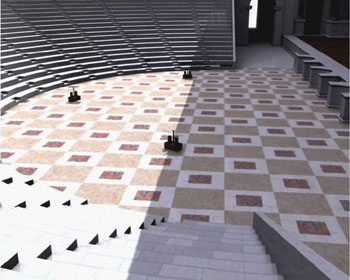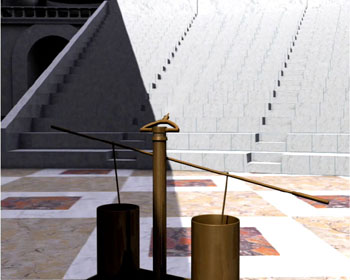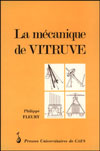Columnae Herculis II (Nova Roma)
(start with second edition) |
(images rearrangement) |
||
| Line 49: | Line 49: | ||
What brings here, for instance, the virtual reconstitution, is to show that three pomps were enough for this task, and that every one of them could just throw its cloud to a limited distance. The experiments made by Pr Fleury’s team have shown that the scope of this splashing covered, in the theater of Pompey, in Rome, the seats where the senators sat. Height of refinement, water was mixed with saffron. | What brings here, for instance, the virtual reconstitution, is to show that three pomps were enough for this task, and that every one of them could just throw its cloud to a limited distance. The experiments made by Pr Fleury’s team have shown that the scope of this splashing covered, in the theater of Pompey, in Rome, the seats where the senators sat. Height of refinement, water was mixed with saffron. | ||
| − | [[Image:Pomp_orchestra.jpg| | + | [[Image:Pomp_orchestra.jpg|left]] |
| + | |||
| + | [[Image:Pomp_jet.jpg|right]] | ||
| + | <br style="clear:both"> | ||
Applied to the same theater, the reconstitution of the stage curtain, which rose from a groove which separated the orchestra from the scene stage, has been conducted according the datas recorded in Arles and Lyons, where a 5 meters high curtain seems to be proved. Virtual reconstitution then let us see that, even from the 37 meters high upper seats rank, the curtain perfectly hided the whole stage. On the contrary, from the seats beyond an approximative angle of 60°, right and left from the stage, spectators could see the stage, but only from a certain distance of the curtain. Must then one consider that the curtain was higher in the Theater of Pompey, if we put that a seat was a lower priced one if you could see, from it, behind the stage curtain? | Applied to the same theater, the reconstitution of the stage curtain, which rose from a groove which separated the orchestra from the scene stage, has been conducted according the datas recorded in Arles and Lyons, where a 5 meters high curtain seems to be proved. Virtual reconstitution then let us see that, even from the 37 meters high upper seats rank, the curtain perfectly hided the whole stage. On the contrary, from the seats beyond an approximative angle of 60°, right and left from the stage, spectators could see the stage, but only from a certain distance of the curtain. Must then one consider that the curtain was higher in the Theater of Pompey, if we put that a seat was a lower priced one if you could see, from it, behind the stage curtain? | ||
| Line 55: | Line 58: | ||
How to conciliate the fact that these 'angle' seats had roughly the same view on the stage than the emperor’s one, from his lobby, located above the right wing (from the stage) vomitorium? May a default for the first ones become a privilege for the last one? | How to conciliate the fact that these 'angle' seats had roughly the same view on the stage than the emperor’s one, from his lobby, located above the right wing (from the stage) vomitorium? May a default for the first ones become a privilege for the last one? | ||
| − | The musical organ asks less questions. This organ itself has to be set on a small rolling trolley, as have been, since, the modern barrel organs. Particularly thanks to materials excavated in Aquicum (Budapest, Hungary), Philippe Fleury has succeeded reconstituting the working plan of the system: an ingenious tank, filled with water, allowed the organist to let the air entering it. The air was then pomped in pipes, thanks to pomps located on both sides of the central part of the organ, and operated by third persons, usually slaves. The quantity of air impulsed determined the sound obtained through the ‘keyboard’. The last one thus allowed the organist to close or to open the tubes through which the air escaped. These tubes had different lengths – as in a panpipe - which gave the different notes. | + | The musical organ asks less questions. This organ itself has to be set on a small rolling trolley, as have been, since, the modern barrel organs. Particularly thanks to materials excavated in Aquicum (Budapest, Hungary), Philippe Fleury has succeeded reconstituting the working plan of the system: an ingenious tank, filled with water, allowed the organist to let the air entering it. The air was then pomped in pipes, thanks to pomps located on both sides of the central part of the organ, and operated by third persons, usually slaves. The quantity of air impulsed determined the sound obtained through the ‘keyboard’. The last one thus allowed the organist to close or to open the tubes through which the air escaped. These tubes had different lengths – as in a panpipe - which gave the different notes. This organ was used during the shows, and maybe also during the burial ceremonies. |
| − | + | ||
| − | + | ||
| − | + | ||
| − | This organ was used during the shows, and maybe also during the burial ceremonies. | + | |
The reconstitution by the Caen team of the Coliseum’s velum shows that it – or rather these 'vela' – formed a huge spider web made of hemp ropes that covered, as a roof, the amphitheatre. The vela slided along main ropes that had been tight from the top of the Coliseum to the center arena zone. This juxtaposition of these long web slats formed the velum as a whole. | The reconstitution by the Caen team of the Coliseum’s velum shows that it – or rather these 'vela' – formed a huge spider web made of hemp ropes that covered, as a roof, the amphitheatre. The vela slided along main ropes that had been tight from the top of the Coliseum to the center arena zone. This juxtaposition of these long web slats formed the velum as a whole. | ||
Revision as of 19:58, 21 November 2007
| ||||
| ||||
| ||||
|
||||




